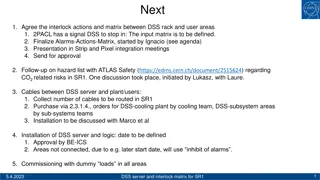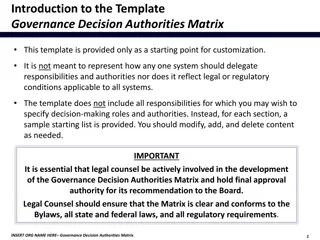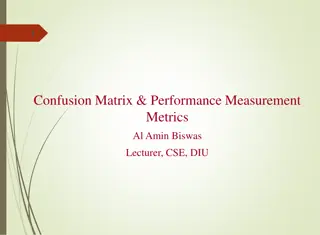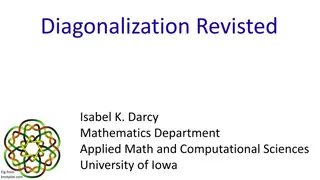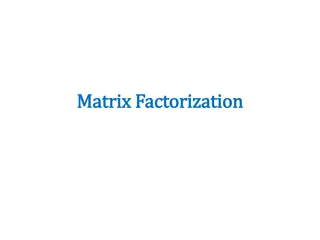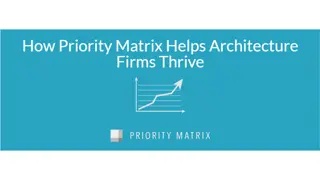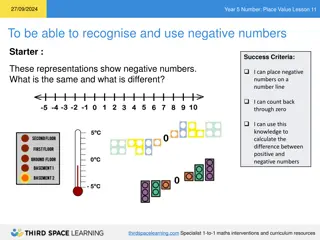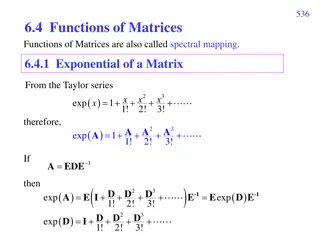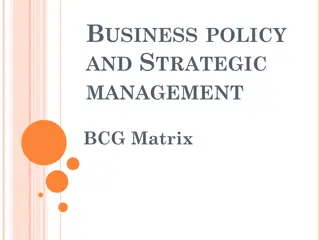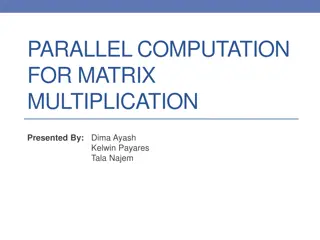Portfolio Matrix: Strategic Product Positioning Guide
Learn about the Portfolio Matrix, a strategic tool assessing products based on industry growth and market share. Explore the BCG matrix, its four categories, and how it guides decision-making for products' future success.
1 views • 14 slides
Composite Materials: Reinforcement and Matrix in Composites
Composite materials consist of reinforcement and matrix components, each serving a specific purpose to enhance the properties of the composite. The reinforcement phase provides strength and stiffness, while the matrix transfers loads and protects the fibers. Different types of reinforcements and mat
8 views • 18 slides
Modeling and Generation of Realistic Network Activity Using Non-Negative Matrix Factorization
The GHOST project focuses on the challenges of modeling, analyzing, and generating patterns of network activity. By utilizing Non-Negative Matrix Factorization (NMF), realistic network activity patterns can be created and injected into live wireless networks. Understanding and predicting user behavi
4 views • 28 slides
Extracellular Matrix (ECM) and Its Functions
Extracellular Matrix (ECM) is a complex network of proteins, glycoproteins, and macromolecules that provide structural support, regulate cell activities, and play crucial roles in various tissues. It consists of two main types - interstitial matrix and basement membrane, each serving specific functi
12 views • 25 slides
The Importance of Completing a Trainer Matrix
Completing a Trainer Matrix is essential for Registered Training Organizations (RTOs) to demonstrate compliance with Standards for RTOs 2015, specifically Clauses 1.13 to 1.16. This matrix outlines requirements for trainers, including holding relevant qualifications, industry skills, and maintaining
2 views • 38 slides
Matrix Organizations and Managing Multiple Principals
Explore the concept of matrix organizations, challenges faced in managing multiple principals, and the importance of accountability, prioritization, and coordination. Learn how matrix structures evolved, their prevalence in modern workforce, and the impact on industries like architecture firms.
1 views • 22 slides
Eisenhower Matrix for Efficient Task Prioritization
Use the Eisenhower Matrix template to effectively prioritize project tasks by distinguishing between urgent and important activities. Delegate, delete, or tackle tasks based on their significance for optimal time management. An example matrix provided showcases various tasks categorized as urgent/im
2 views • 4 slides
Interlock Actions and Matrix for DSS Server in SR1 Environment
Proposal and implementation plan for interlock actions and matrix coordination between DSS server rack and user areas in SR1. Includes agreements, alarms-actions matrix finalization, cable routing, server installation, and commissioning with dummy loads. Discusses CO2 plant signals, temperature moni
5 views • 7 slides
Matrices in Precalculus: Order, Augmented Matrix, and Row-Echelon Form
Delve into the world of matrices in Precalculus with a focus on identifying matrix orders, creating augmented matrices for systems of equations, transforming matrices into row-echelon form, and solving linear equations using matrices. Explore elementary row operations, row-echelon form, and reduced
2 views • 37 slides
Singular Value Decomposition (SVD)
Singular Value Decomposition (SVD) is a powerful method for solving systems of linear equations or matrices that are singular or close to singular. When LU-decomposition or Gaussian elimination fail, SVD provides a stable matrix decomposition helpful in various applications. It is particularly usefu
0 views • 17 slides
Governance Decision Authorities Matrix Overview
A Governance Decision Authorities Matrix is a crucial tool that articulates roles and responsibilities for major decision-making within a system. This template provides a starting point for customizing governance structures, focusing on areas like fiduciary responsibilities, strategic planning, qual
3 views • 9 slides
Singular Value Decomposition
The Singular Value Decomposition (SVD) is a powerful factorization method for matrices, extending the concept of eigenvectors and eigenvalues to non-symmetric matrices. This decomposition allows any matrix to be expressed as the product of three matrices: two orthogonal matrices and a diagonal matri
0 views • 35 slides
Singular Value Decomposition and the Conjugate Gradient Method
Singular Value Decomposition (SVD) is a powerful method that decomposes a matrix into orthogonal matrices and diagonal matrices. It helps in understanding the range, rank, nullity, and goal of matrix transformations. The method involves decomposing a matrix into basis vectors that span its range, id
0 views • 21 slides
Intervention Planning Matrix for Enhanced Learning Support
Enhance learning support with the Intervention Planning Matrix tool developed by the Healthy Wisconsin Leadership Institute. This tool helps brainstorm strategies for impactful policy changes and community interventions. Utilize the tips provided to maximize the effectiveness of the tool, and engage
0 views • 7 slides
Confusion Matrix and Performance Measurement Metrics
Explore the concept of confusion matrix, a crucial tool in evaluating the performance of classifiers. Learn about True Positive, False Negative, False Positive, and True Negative classifications. Dive into performance evaluation metrics like Accuracy, True Positive Rate, False Positive Rate, False N
3 views • 13 slides
Diagonalization in Mathematics
Diagonalization plays a crucial role in converting complex problems into simpler ones by allowing matrices to be represented in a diagonal form. The process involves finding eigenvalues and corresponding eigenvectors, ultimately leading to a diagonal matrix representation. However, careful considera
0 views • 36 slides
Diagonalization in Linear Algebra
Discover the concept of diagonalization in linear algebra through eigenvectors, eigenvalues, and diagonal matrices. Learn the conditions for a matrix to be diagonalizable, the importance of eigenvectors in forming an invertible matrix, and the step-by-step process to diagonalize a matrix by finding
0 views • 26 slides
Advancements in Quantum Systems Techniques for Density Matrix Minimization
Discover the innovative methods and applications of open quantum systems techniques for density matrix minimization. Explore the motivation behind the research, early developments, purification processes, linear scaling potentials, Bloch's method intricacies, quantum channel algorithms, canonical de
0 views • 22 slides
Matrix Algebra for Solving Systems of Equations
Explore the application of matrix algebra in solving systems of equations through a practical example involving the interpolation of rocket velocity data. Learn how to set up equations in matrix form to find the coefficients profile of the velocity polynomial, illustrating the concept effectively.
0 views • 71 slides
Rank and Nullity in Linear Algebra
The rank of a matrix is the maximum number of linearly independent columns, while the nullity is obtained by subtracting the rank from the number of columns. Linearly independent columns form the basis for the rank of a matrix, helping determine if a given matrix has a unique solution, infinite solu
0 views • 6 slides
Matrix Factorization for Latent Factor Recovery
Explore the concept of matrix factorization for recovering latent factors in a matrix, specifically focusing on user ratings of movies. This technique involves decomposing a matrix into multiple matrices to extract hidden patterns and relationships. The process is crucial for tasks like image denois
0 views • 50 slides
Improved Rectangular Matrix Multiplication Using Coppersmith-Winograd Tensor
In this research, the complexity of rectangular matrix multiplication is enhanced by analyzing the fourth power of the Coppersmith-Winograd tensor. By extending the understanding of the tensor's power, significant advancements have been made in the efficiency of non-square matrix multiplication, sur
0 views • 25 slides
Linear Equations and Matrix Operations
Explore the concepts of linear equations, matrix forms, determinants, and finding solutions for variables like x1, x2, x3. Learn about Cramer's Rules, Adjoint Matrix, and calculating the inverse of a matrix through examples and formulas.
0 views • 24 slides
Priority Matrix in Teams
Priority Matrix is a valuable tool in the A/C/E industry, allowing teams to prioritize tasks efficiently, communicate priorities effectively, and track progress accurately. Real teams benefit from its use cases in prioritization, communication, and progress tracking, creating a roadmap for workflow
0 views • 23 slides
Student Discipline Reporting and the Discipline Matrix in Georgia Schools
Explore the Student Discipline Reporting and Unsafe School Choice Option program in Georgia schools, led by Jeff Hodges and Richard Woods. Learn about the Discipline Matrix, its purpose, and how it improves data accuracy, transparency, and addresses concerns related to discipline actions. Discover h
0 views • 35 slides
Global Matrix 4.0 Spanish Report Card Leaders Meeting Overview
The Global Matrix 4.0 Spanish Report Card Leaders Meeting provides insights into national and regional report cards, introduction of Spanish leaders, and discussions on national coordination and future opportunities for various regions. The meeting aims to harmonize messaging, share information, and
0 views • 9 slides
Advanced Circuit Simulation Using Matrix Exponential Operators
Explore the innovative approach of circuit simulation via matrix exponential operators as proposed by CK Cheng from UC San Diego. The method involves utilizing general matrix exponentials, Krylov spaces, Arnoldi orthonormalization, and inverting Krylov subspaces for accurate simulations. These techn
0 views • 28 slides
Multiple Regression Analysis of Energy Consumption in Luxury Hotels - Hainan Province, China
Conducting a multiple regression analysis on the energy consumption of luxury hotels in Hainan Province, China using matrix form in Excel. The dataset includes 19 luxury hotels with the dependent variable being energy consumption (1M kWh) and predictors such as area, age, and effective number of gue
0 views • 13 slides
Revolutionizing Hotel Communication with Matrix Hospitality Solution
Simplify hotel operations and enhance guest experiences with Matrix Hospitality Solution. From enhancing staff efficiency to boosting revenue generation opportunities, Matrix offers a comprehensive suite of features to meet the diverse needs of hotels. Its modular configuration, scalable platform, a
1 views • 36 slides
Negative Numbers in Year 5 Mathematics Lesson
In this Year 5 mathematics lesson on negative numbers, students learn to recognize and use negative numbers through various activities such as placing them on a number line, counting back through zero, and calculating the differences between positive and negative numbers. The lesson also prompts stu
0 views • 23 slides
Matrix Measurements and Analysis After First Metal Workshop
The pilot run matrix measurements were conducted following the 7th Belle II VXD workshop and the 18th International Workshop on DEPFET Detectors and Applications by Rainer H. Richter and Paola Avella for the MPP/HLL team. The measurements included assessing defects, diode integrity, metal shorts, an
0 views • 30 slides
Composite Matrix Materials in Engineering
Composite materials are made of reinforcing fibers and matrix materials, with the matrix serving to protect and enhance the properties of the composite. There are three main types of composite matrix materials: metal matrix composites (MMC), ceramic matrix composites (CMC), and polymer matrix compos
0 views • 22 slides
Non-Negative Tensor Factorization with RESCAL
This article discusses non-negative tensor factorization with RESCAL, covering topics such as Non-Negative Matrix Factorization, Multiplicative Updates, RESCAL for Relational Learning, and Non-Negative Constraint for RESCAL. It explores how factorizing matrices/tensors into non-negative factors can
0 views • 11 slides
Creating Effective Expectation Matrix for School Environment
Engage in a structured activity to develop behavior guidelines using an expectation matrix. Follow guidelines to positively state rules, keep them concise, and focus on desired behaviors. Utilize sticky notes to define specific rules per setting and location. Gather insights to build a schoolwide be
0 views • 5 slides
Matrix Functions and Taylor Series in Mathematics
A detailed exploration of functions of matrices, including exponential of a matrix, eigenvector sets, eigenvalues, Jordan-Canonical form, and applications of Taylor series to compute matrix functions like cosine. The content provides a deep dive into spectral mapping, eigenvalues, eigenvectors, and
0 views • 53 slides
BCG Matrix: Market Growth and Relative Market Share
BCG Matrix, developed by Bruce Henderson of the Boston Consulting Group, categorizes business units into Question Marks, Stars, Cash Cows, and Dogs based on market growth and relative market share. Market share and market growth are crucial factors in determining a company's position in the market.
0 views • 31 slides
Understanding a Bus Matrix Analytics in Power BI
A bus matrix is a two-dimensional visualization in Power BI that shows the intersection of facts (additive amounts) and dimensions (descriptive attributes), enabling relationships between data fields. This concept is crucial for running cross-process analysis efficiently. Star-schema examples demons
0 views • 5 slides
Parallel Computation for Matrix Multiplication
Matrix multiplication is a fundamental operation with diverse applications across scientific research. Parallel computation for matrix multiplication involves distributing the computational workload over multiple processors, improving efficiency. Different algorithms have been developed for multiply
0 views • 36 slides
Matrix Video Surveillance Solution for Retail - Enhancing Security and Productivity
Matrix offers a comprehensive video surveillance solution for retail businesses, enhancing security and productivity. Their real-time security features help trace customer belongings and deter theft. Additionally, their productivity solutions aid in managing heavy customer flow, ensuring employee di
0 views • 14 slides
Monitoring Matrix on Enabling Environment for Civil Society Development - Insights and Perspectives
Explore insights from a partners workshop in Prishtina, Kosovo, discussing the value and relevance of the Monitoring Matrix exercise for civil society development. Learn about research beyond the Matrix, respondent engagement, and ideal implementation scenarios.
0 views • 24 slides







